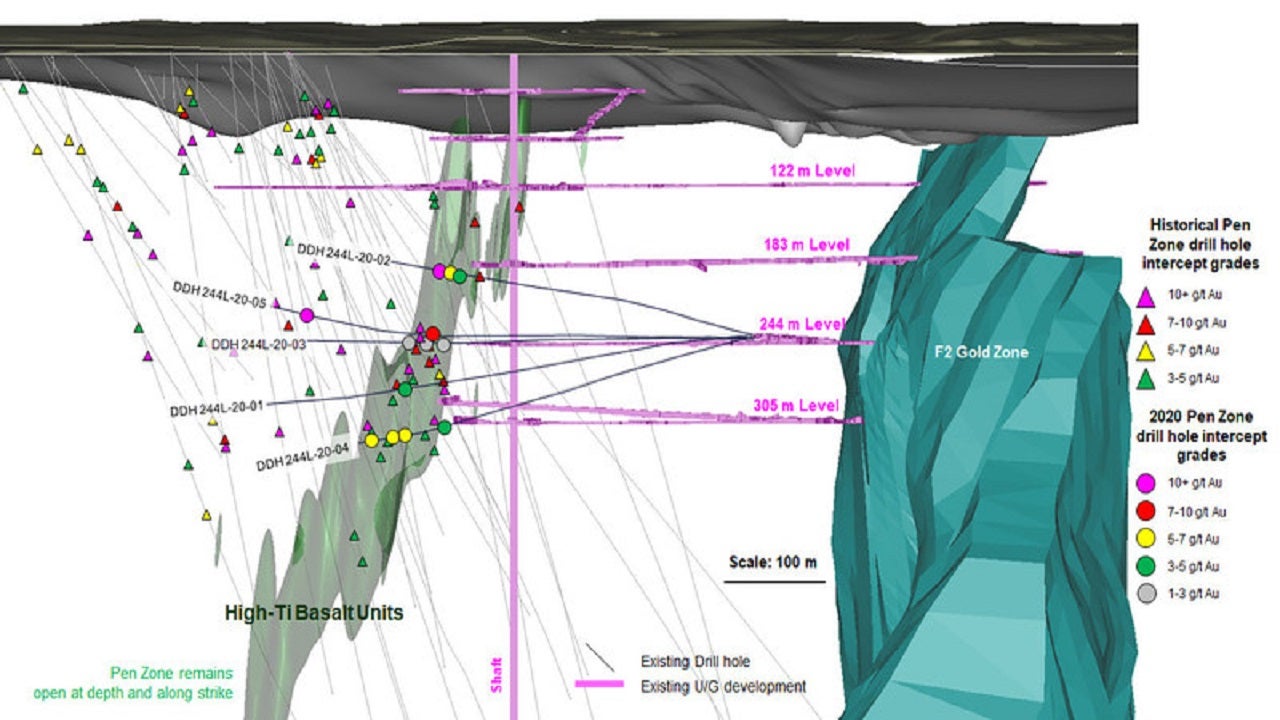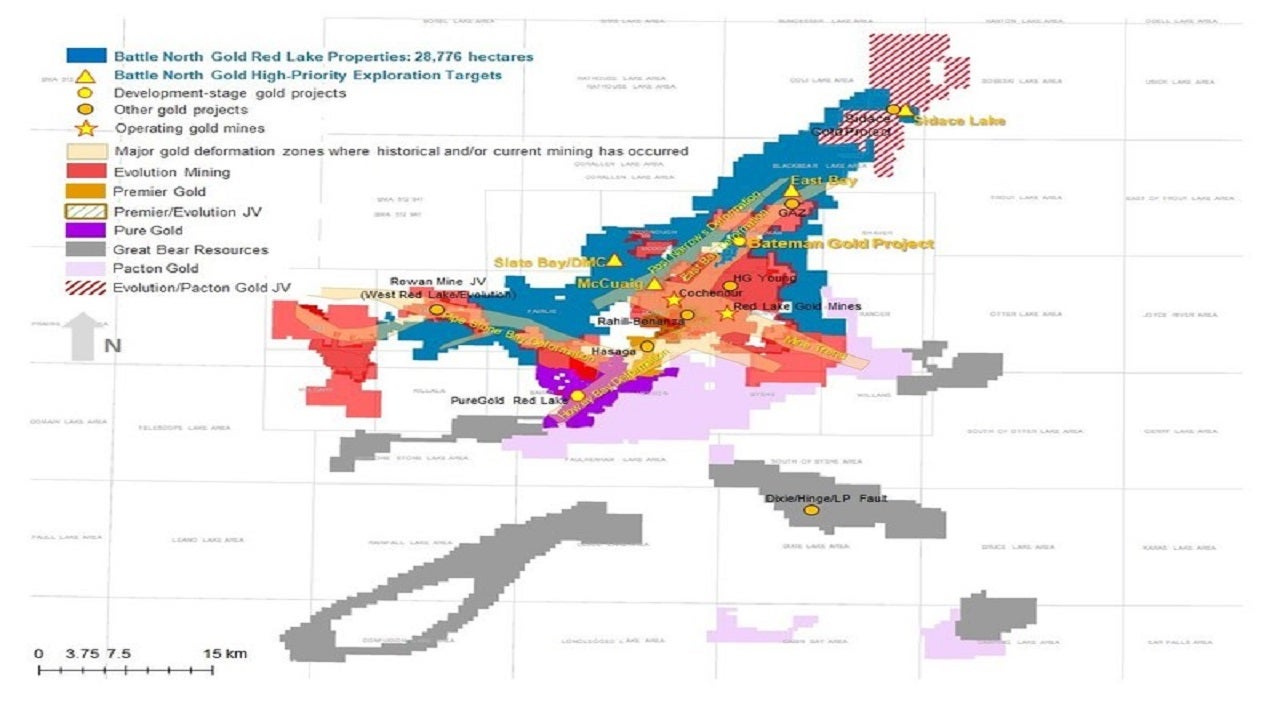The Bateman project is an underground gold development in Ontario, Canada. It is 100% owned by Battle North Gold, a Canadian gold miner.
The positive feasibility study for the gold project was announced in October 2020. The project will mine 403 stopes, which together comprise more than 3.5 million tonnes (Mt) of ore, over its estimated life of mine (LOM) of 8.2 years. The total LOM gold production is estimated to be 602,987oz.
The gold mine consists of the high-grade F2 gold deposit of high-grade archean lode gold and more than 14,000m of underground developed mine workings.
Canadian firm Franco-Nevada has a 2% royalty on water claims while Royal Gold holds a 1% royalty on land claims.
Bateman project location
The Bateman gold project is located in the Red Lake mining district of northwestern Ontario, Canada.
The mine is situated on a 525ha site at an elevation of 369m above sea level on East Bay of Red Lake municipality in the southwestern part of Bateman Township.
The site is accessible via an 8km gravel road from the Cochenour community, part of Red Lake.
Geology
The East Bay area’s stratigraphy includes submarine tholeiitic basalt, komatiite and komatiitic basalt with minor felsic intrusive volcanic rock, iron formation, and fine‐grained clastic metasedimentary rocks, which collectively form the Balmer assemblage.
Low-grade mineralisation exists as quartzactinolitesulphide veins and stringers, as well as in the form of disseminated mineralisation related to quartzbiotite sulphide alteration in the high‐Ti basalt and felsic intrusive units.
Higher-grade mineralisation exists as a cluster of shear‐related veins and minor localised shear zones. The presence of gold mineralisation is linked with disseminated sulphide mineralisation in the high‐Ti basalt and gold‐bearing quartzactinolite veins in the high‐Ti basalt and felsic intrusive units.
Bateman gold project reserves
The proven and probable reserves of the Bateman gold project are estimated to be 3.56 million tonnes (Mt) of gold graded at 5.54g/t of gold (Au) containing 634,838oz of gold, as of September 2020.
Mining at Bateman gold project
The feasibility study considered four mining methods, namely sub-level long hole (bulk mining), cut-and-fill (selective mining), uppers long hole (bulk mining), and mass blasting raise mining (MBRM, bulk mining).
The sub-level long-hole method involves the development of the ore body at regular vertical intervals. A blasting slot will be created at one end of the excavation, and mining of the blocks will retreat along the strike of the stope. The method will be applicable to thicker areas of the deposit.
The uppers long-hole method, which is generally used along with long hole (LH) mining, includes driving a drift along the strike of the mineralised zone, placing an inverse raise at the stope extremity, and production drilling of holes. It is best suited for areas with known ore continuity and limited strike length.
Mechanised cut-and-fill is a moderately productive and highly selective mining method. On the other hand, MBRM is highly productive and begins with lateral development of a bottom sill and stope undercut to enable long hole dump mucking, along with the creation of void space for production blasts.
The mined ore will be mucked from the stope draw point and sent to level re-mucks for haulage by trucks to surface or the 610m level truck dump/grizzly before it is skipped to surface and stockpiled. The stockpiled ore will then be transported to the primary surface crusher where it will be crushed to a minimum size of 150mm before processing at the mill.
Processing at Bateman gold project
The Bateman mine includes an operational mill processing facility at the site. The main components of the processing mill are a semi-autogenous grinding (SAG) grinding unit, Knelson gravity concentrators, carbon-in-leach circuit, and a ball mill.
The current capacity of the mill is up to 1,250tpd, but the grinding mills are capable of processing approximately 1,800tpd with minor upgrades.
The mill has scope for the installation of a second ball mill, an additional hydrocyclone cluster, and a second stripping column to enhance the processing capacity up to 2,500tpd.
Excess mill capacity will facilitate the processing of increased production from the F2 deposit and the mine’s McFinley and Pen Zone targets.
A 21-month ramp-up period will lead to commercial production in the first year of LOM, while stockpiling of ore will be started soon after the beginning of the construction. Processing of stockpiles is expected to begin after seven months of the pre-commercial production period.
Infrastructure at the gold project
The project includes an existing tailings management facility (TMF) and operating water treatment plant. The TMF is planned to be expanded and an ammonia treatment unit is to be added to the current water treatment plant.
Electrical supply to the site is from a 44kV M6 Hydro One line from the Red Lake Distribution Station (DS). The line feeds the main substation, which contains two 18MW transformers feeding a common 5kW bus supplying the site.
The mine can access the natural gas present in the Red Lake area as an alternative form of energy in future.
Water is procured from the adjacent East Bay of Red Lake to feed the process water and underground activities. The site also includes a 200-person accommodation camp.






